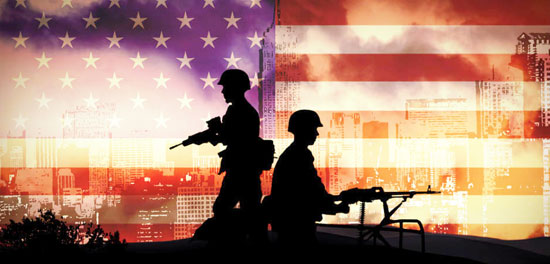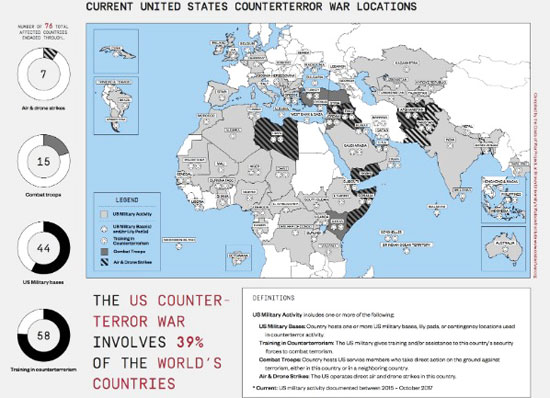Seeing Our Wars for the First Time – Mapping a World From Hell 76 Countries Are Involved in Washington’s War on Terror poza He left Air Force Two
76 Countries Are Involved in Washington’s War on Terror

He left Air Force Two behind and, unannounced, shrouded in secrecy, flew on an unmarked C-17 transport plane into Bagram Air Base, the largest American garrison in Afghanistan. All news of his visit was embargoed until an hour before he was to depart the country.
More than 16 years after an American invasion “liberated” Afghanistan, he was there to offer some good news to a U.S. troop contingent once again on the rise. Before a 40-foot American flag, addressing 500 American troops, Vice President Mike Pence praised them as “the world’s greatest force for good,” boasted that American air strikes had recently been “dramatically increased,” swore that their country was “here to stay,” and insisted that “victory is closer than ever before.” As an observer noted, however, the response of his audience was “subdued”. (“Several troops stood with their arms crossed or their hands folded behind their backs and listened, but did not applaud.”)
Think of this as but the latest episode in an upside down geopolitical fairy tale, a grim, rather than Grimm, story for our age that might begin: Once upon a time – in October 2001, to be exact – Washington launched its war on terror. There was then just one country targeted, the very one where, a little more than a decade earlier, the U.S. had ended a long proxy war against the Soviet Union during which it had financed, armed, or backed an extreme set of Islamic fundamentalist groups, including a rich young Saudi by the name of Osama bin Laden.
By 2001, in the wake of that war, which helped send the Soviet Union down the path to implosion, Afghanistan was largely (but not completely) ruled by the Taliban. Osama bin Laden was there, too, with a relatively modest crew of cohorts. By early 2002, he had fled to Pakistan, leaving many of his companions dead and his organization, al-Qaeda, in a state of disarray. The Taliban, defeated, were pleading to be allowed to put down their arms and go back to their villages, an abortive process that Anand Gopal vividly described in his book, No Good Men Among the Living.
It was, it seemed, all over but the cheering and, of course, the planning for yet greater exploits across the region. The top officials in the administration of President George W. Bush and Vice President Dick Cheney were geopolitical dreamers of the first order who couldn’t have had more expansive ideas about how to extend such success to – as Secretary of Defense Donald Rumsfeld indicated only days after the 9/11 attacks – terror or insurgent groups in more than 60 countries. It was a point President Bush would reemphasize nine months later in a triumphalist graduation speech at West Point. At that moment, the struggle they had quickly, if immodestly, dubbed the Global War on Terror was still a one-country affair. They were, however, already deep into preparations to extend it in ways more radical and devastating than they could ever have imagined with the invasion and occupation of Saddam Hussein’s Iraq and the domination of the oil heartlands of the planet that they were sure would follow. (In a comment that caught the moment exactly, Newsweek quoted a British official “close to the Bush team” as saying, “Everyone wants to go to Baghdad. Real men want to go to Tehran.”)
So many years later, perhaps it won’t surprise you – as it probably wouldn’t have surprised the hundreds of thousands of protesters who turned out in the streets of American cities and towns in early 2003 to oppose the invasion of Iraq – that this was one of those stories to which the adage “be careful what you wish for” applies.
Seeing War
And it’s a tale that’s not over yet. Not by a long shot. As a start, in the Trump era, the longest war in American history, the one in Afghanistan, is only getting longer. There are those U.S. troop levels on the rise; those air strikes ramping up; the Taliban in control of significant sections of the country; an Islamic State-branded terror group spreading ever more successfully in its eastern regions; and, according to a recent report from the Pentagon, “more than 20 terrorist or insurgent groups in Afghanistan and Pakistan.”
Think about that: 20 groups. In other words, so many years later, the war on terror should be seen as an endless exercise in the use of multiplication tables – and not just in Afghanistan either. More than a decade and a half after an American president spoke of 60 or more countries as potential targets, thanks to the invaluable work of a single dedicated group, the Costs of War Project at Brown University’s Watson Institute for International and Public Affairs, we finally have a visual representation of the true extent of the war on terror. That we’ve had to wait so long should tell us something about the nature of this era of permanent war.

America’s war on terror across the globe (from the Costs of War Project)
The Costs of War Project has produced not just a map of the war on terror, 2015-2017, but the first map of its kind ever. It offers an astounding vision of Washington’s counterterror wars across the globe: their spread, the deployment of U.S. forces, the expanding missions to train foreign counterterror forces, the American bases that make them possible, the drone and other air strikes that are essential to them, and the U.S. combat troops helping to fight them. (Terror groups have, of course, morphed and expanded riotously as part and parcel of the same process.)
A glance at the map tells you that the war on terror, an increasingly complex set of intertwined conflicts, is now a remarkably global phenomenon. It stretches from the Philippines (with its own ISIS-branded group that just fought an almost five-month-long campaign that devastated Marawi, a city of 300,000) through South Asia, Central Asia, the Middle East, North Africa, and deep into West Africa where, only recently, four Green Berets died in an ambush in Niger.
No less stunning are the number of countries Washington’s war on terror has touched in some fashion. Once, of course, there was only one (or, if you want to include the United States, two). Now, the Costs of War Project identifies no less than 76 countries, 39% of those on the planet, as involved in that global conflict. That means places like Afghanistan, Syria, Iraq, Yemen, Somalia, and Libya where U.S. drone or other air strikes are the norm and U.S. ground troops (often Special Operations forces) have been either directly or indirectly engaged in combat. It also means countries where U.S. advisers are training local militaries or even militias in counterterror tactics and those with bases crucial to this expanding set of conflicts. As the map makes clear, these categories often overlap.
Who could be surprised that such a “war” has been eating American taxpayer dollars at a rate that should stagger the imagination in a country whose infrastructure is now visibly crumbling? In a separate study, released in November 2017, the Costs of War Project estimated that the price tag on the war on terror (with some future expenses included) had already reached an astronomical $5.6 trillion. Only recently, however, President Trump, now escalating most of those conflicts, tweeted an even more staggering figure: “After having foolishly spent $7 trillion in the Middle East, it is time to start rebuilding our country!” (This figure, too, seems to have come in some fashion from the Costs of War estimate that “future interest payments on borrowing for the wars will likely add more than $7.9 trillion to the national debt” by mid-century.)
It couldn’t have been a rarer comment from an American politician, as in these years assessments of both the monetary and human costs of war have largely been left to small groups of scholars and activists. The war on terror has, in fact, spread in the fashion today’s map lays out with almost no serious debate in this country about its costs or results. If the document produced by the Costs of War project is, in fact, a map from hell, it is also, I believe, the first full-scale map of this war ever produced.
Think about that for a moment. For the last 16 years, the American people, funding this complex set of conflicts to the tune of trillions of dollars, have lacked a single map of the war Washington has been fighting. Not one. Yes, parts of that morphing, spreading set of conflicts have been somewhere in the news regularly, though seldom (except when there were “lone wolf” terror attacks in the United States or Western Europe) in the headlines. In all those years, however, no American could see an image of this strange, perpetual conflict whose end is nowhere in sight.
Part of this can be explained by the nature of that “war.” There are no fronts, no armies advancing on Berlin, no armadas bearing down on the Japanese homeland. There hasn’t been, as in Korea in the early 1950s, even a parallel to cross or fight your way back to. In this war, there have been no obvious retreats and, after the triumphal entry into Baghdad in 2003, few advances either.
It was hard even to map its component parts and when you did – as in a New York Times map of territories controlled by the Taliban in Afghanistan – the imagery was complex and of limited impact. Generally, however, we, the people, have been demobilized in almost every imaginable way in these years, even when it comes to simply following the endless set of wars and conflicts that go under the rubric of the war on terror.
yogaesoteric
March 6, 2019
